The Effect of Copper Content on the Mechanical and Tribological Properties of Hypo-, Hyper- and Eutectoid Ti-Cu Alloys
Abstract
1. Introduction
2. Experiment
2.1. Materials and Preparation
2.2. Mechanical and Tribological Properties
3. Results and discussion
3.1. Mechanical Properties of the Ti-Cu Alloys
3.2. Tribological Properties of the Ti-Cu Alloys
3.3. Effect of Ti2Cu on Mechanical Properties and Tribological Properties
4. Conclusions
Author Contributions
Funding
Conflicts of Interest
References
- Akbarpour, M.; Javadhesari, S.M. Wear performance of novel nanostructured Ti-Cu intermetallic alloy as a potential material for biomedical applications. J. Alloy. Compd. 2017, 699, 882–886. [Google Scholar] [CrossRef]
- Alshammari, Y.; Jia, M.; Yang, F.; Bolzoni, L. The effect of α+ β forging on the mechanical properties and microstructure of binary titanium alloys produced via a cost-effective powder metallurgy route. Mater. Sci. Eng. A 2020, 769, 138–496. [Google Scholar] [CrossRef]
- Luo, Q.S.; Li, S.F.; Pei, H.P. Progress in titanium fire resistant technology for aero-engine. J. Aerospace Power 2012, 27, 2763–2768. [Google Scholar]
- Liu, R.; Ma, Z.; Kolawole, S.K.; Zeng, L.; Zhao, Y.; Ren, L.; Yang, K. In vitro study on cytocompatibility and osteogenesis ability of Ti–Cu alloy. J. Mater. Sci. Mater. Electron. 2019, 30, 75. [Google Scholar] [CrossRef]
- Wang, J.; Zhang, S.; Sun, Z.; Wang, H.; Ren, L.; Yang, K. Optimization of mechanical property, antibacterial property and corrosion resistance of Ti-Cu alloy for dental implant. J. Mater. Sci. Technol. 2019, 35, 2336–2344. [Google Scholar] [CrossRef]
- Dang, W.; Ren, S.; Zhou, J.; Yu, Y.; Li, Z.; Wang, L. Influence of Cu on the mechanical and tribological properties of Ti 3 SiC 2. Ceram. Int. 2016, 42, 9972–9980. [Google Scholar] [CrossRef]
- Wang, W.; Li, Q.; Du, A.; Fan, Y.; Zhao, X.; Yu, Y.; Ma, R.; Cao, X. Effects of Cu content on the wettability of SiC with Al-Ti-Si-xCu alloy and bending strength of resulting SiC matrix composite. Ceram. Int. 2018, 44, 5327–5335. [Google Scholar] [CrossRef]
- Campo, K.N.; De Lima, D.D.; Lopes, É.S.N.; Caram, R. On the selection of Ti–Cu alloys for thixoforming processes: Phase diagram and microstructural evaluation. J. Mater. Sci. 2015, 50, 8007–8017. [Google Scholar] [CrossRef]
- Javadhesari, S.M.; Alipour, S.; Akbarpour, M. Biocompatibility, osseointegration, antibacterial and mechanical properties of nanocrystalline Ti-Cu alloy as a new orthopedic material. Colloids Surf. B Biointerfaces 2020, 189, 110–889. [Google Scholar] [CrossRef]
- Tao, S.; Xu, J.; Yuan, L.; Luo, J.; Zheng, Y. Microstructure, mechanical properties and antibacterial properties of the microwave sintered porous Ti–3Cu alloys. J. Alloy. Compd. 2020, 812, 142–152. [Google Scholar] [CrossRef]
- Paul, H.; Chulist, R.; Miszczyk, M.M.; Cios, G.; Galka, A.; Skuza, W.; Petrzak, P.; Mania, I. Interfacial reactions and structural properties of explosively welded titanium/copper plates. IOP Conf. Ser. Mater. Sci. Eng. 2020, 770, 12–33. [Google Scholar] [CrossRef]
- Bohórquez, C.D.; Pérez, S.P.; Sarmiento, A.; Mendoza, M.E. Effect of temperature on morphology and wear of a Cu-Ti-TiC MMC sintered by abnormal glow discharge. Mater. Res. Express. 2020, 7, 26–501. [Google Scholar]
- Campo, K.; Lopes, E.; Parrish, C.; Caram, R. Rapid quenching of semisolid Ti-Cu alloys: Insights into globular microstructure formation and coarsening. Acta Mater. 2017, 139, 86–95. [Google Scholar] [CrossRef]
- Souza, S.; Afonso, C.R.M.; Ferrandini, P.; Coelho, A.; Caram, R. Effect of cooling rate on Ti–Cu eutectoid alloy microstructure. Mater. Sci. Eng. C 2009, 29, 1023–1028. [Google Scholar] [CrossRef]
- Andrade, P.; Coelho, A.; Afonso, C.R.M.; Contieri, R.; Robert, M.H.; Caram, R. Effects of composition on solidification microstructure of cast titanium Alloys. Mater. Sci. Forum 2010, 649, 183–188. [Google Scholar] [CrossRef]
- Li, J.; Yu, N.; Jiang, H.; Leng, J.; Geng, H. Effects of annealing temperature on dealloying of Ti–Cu Alloy. Corros. Sci. 2015, 91, 95–100. [Google Scholar] [CrossRef]
- Kikuchi, M.; Takada, Y.; Kiyosue, S.; Yoda, M.; Woldu, M.; Cai, Z.; Okuno, O.; Okabe, T. Mechanical properties and microstructures of cast Ti–Cu alloys. Dent. Mater. 2003, 19, 174–181. [Google Scholar] [CrossRef]
- Kolawole, S.K.; Hai, W.; Zhang, S.; Sun, Z.; Siddiqui, M.A.; Ullah, I.; Yang, K. Preliminary study of microstructure, mechanical properties and corrosion resistance of antibacterial Ti-15Zr-xCu alloy for dental application. J. Mater. Sci. Technol. 2020, 50, 31–43. [Google Scholar] [CrossRef]
- Wu, J.-H.; Chen, K.-K.; Chao, C.-Y.; Chang, Y.-H.; Du, J.-K. Effect of Ti2Cu precipitation on antibacterial property of Ti-5Cu alloy. Mater. Sci. Eng. C 2020, 108, 110433. [Google Scholar] [CrossRef]
- Zhang, E.; Fu, S.; Wang, R.-X.; Li, H.-X.; Liu, Y.; Ma, Z.-Q.; Liu, G.-K.; Zhu, C.-S.; Qin, G.-W.; Chen, D.-F. Role of Cu element in biomedical metal alloy design. Rare Met. 2019, 38, 476–494. [Google Scholar] [CrossRef]
- Hayama, A.O.; Andrade, P.N.; Cremasco, A.; Contieri, R.; Afonso, C.R.M.; Caram, R. Effects of composition and heat treatment on the mechanical behavior of Ti–Cu alloys. Mater. Des. 2014, 55, 1006–1013. [Google Scholar] [CrossRef]
- Lincai, Z.; Xiaoming, D.; Wei, Y.; Man, Z.; Zhenya, S. Effect of prestrain on precipitation behaviors of Ti-2.5Cu alloy. High Temp. Mater. Process. 2018, 37, 487–493. [Google Scholar] [CrossRef]
- Cherenda, N.; Basalai, A.; Uglov, V.; Laskovnev, A.; Astashynski, V.; Kuzmitski, A. Phase composition and mechanical properties of Cu–Ti alloys synthesized in the surface layer of copper by plasma impact on the Ti/Cu system. Vacuum 2019, 167, 452–458. [Google Scholar] [CrossRef]
- Zhang, X.; Yu, Y.; Liu, B.; Ren, J. Mechanical properties and tensile fracture mechanism investigation of Al/Cu/Ti/Cu/Al laminated composites fabricated by rolling. J. Alloy. Compd. 2019, 805, 338–345. [Google Scholar] [CrossRef]
- Cardoso, F.F.; Cremasco, A.; Contieri, R.J.; Lopes, E.S.N.; Afonso, C.R.M.; Caram, R. Hexagonalmartensite decomposition and phase precipitation in Ti–Cu alloys. Mater. Des. 2011, 32, 4608–4613. [Google Scholar] [CrossRef]
- Fowler, L.; Masia, N.; Cornish, L.A.; Chown, L.H.; Engqvist, H.; Norgren, S.; Öhman, C. Development of antibacterial Ti-Cux alloys for dental applications: Effects of ageing for alloys with Up to 10 wt% Cu. Materials 2019, 12, 4017. [Google Scholar] [CrossRef]
- Yu, F.; Wang, H.; Yuan, G.; Shu, X. Effect of Cu content on wear resistance and mechanical behavior of Ti–Cu binary alloys. Appl. Phys. A 2017, 123, 472. [Google Scholar] [CrossRef]
- Chen, Y.; Wei, J.; Zhao, Y.; Sun, J. Effect of semi-solid forging temperature on microstructure and mechanical properties of Ti14 alloy. J. Alloy. Compd. 2009, 487, 314–320. [Google Scholar] [CrossRef]
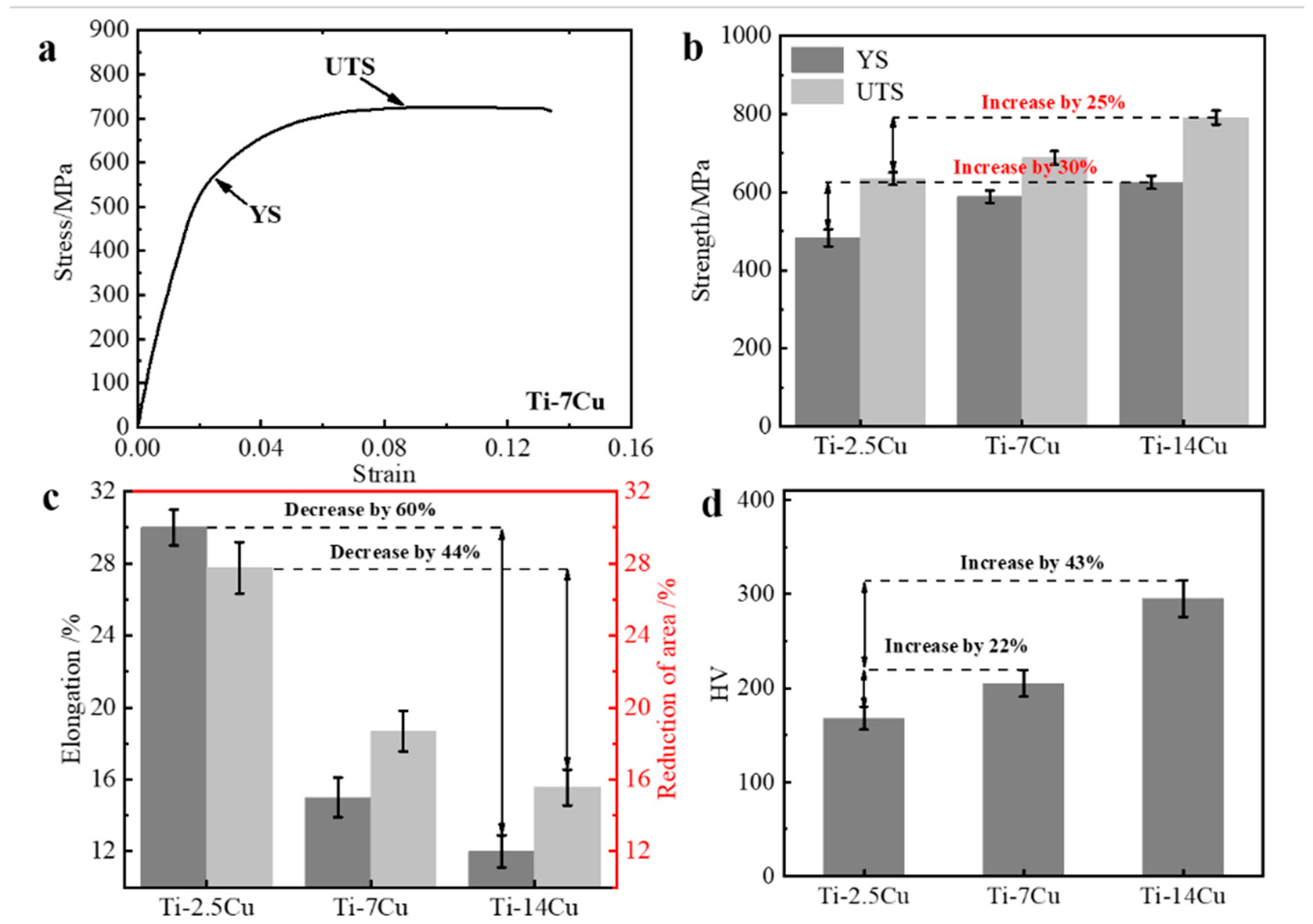
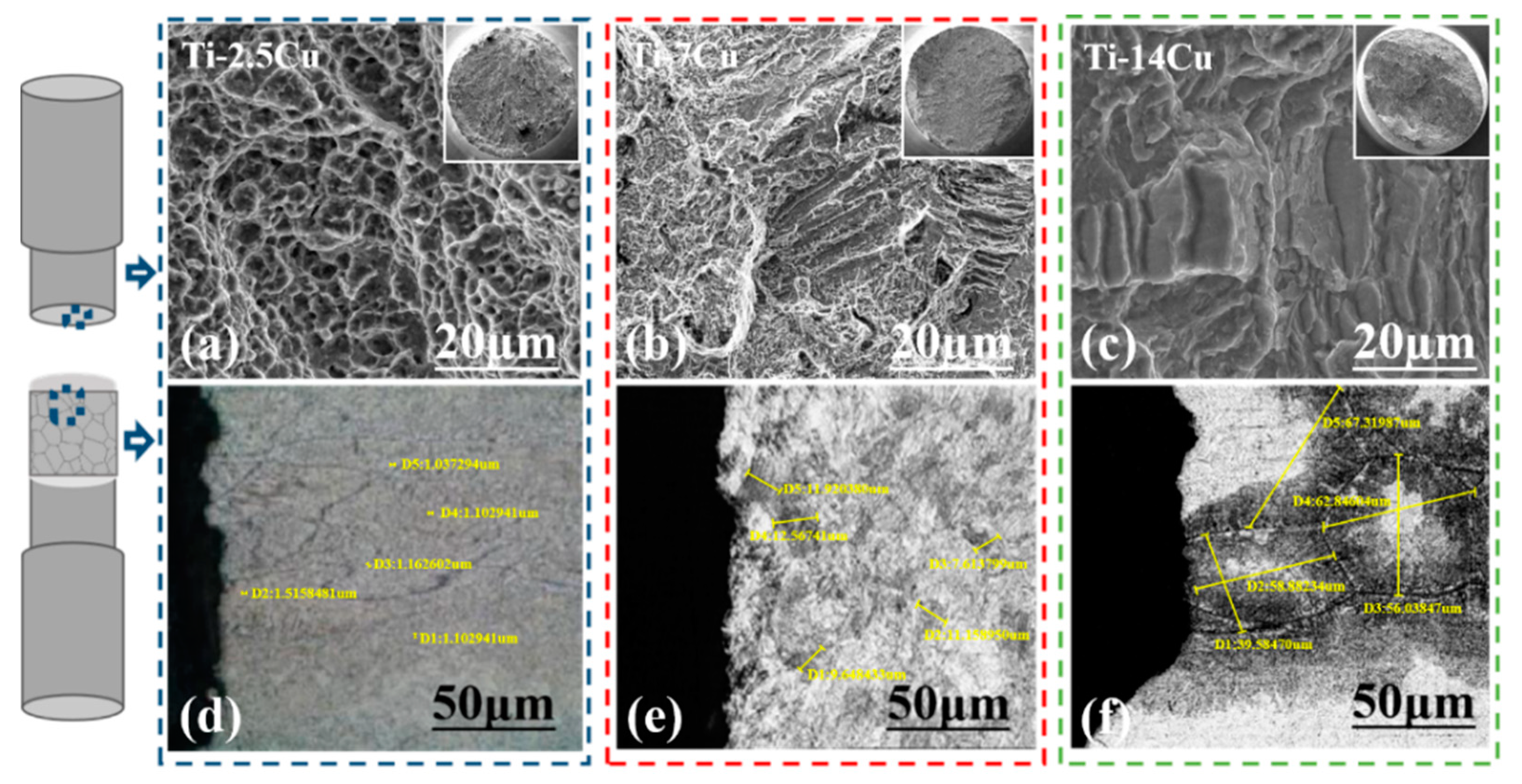
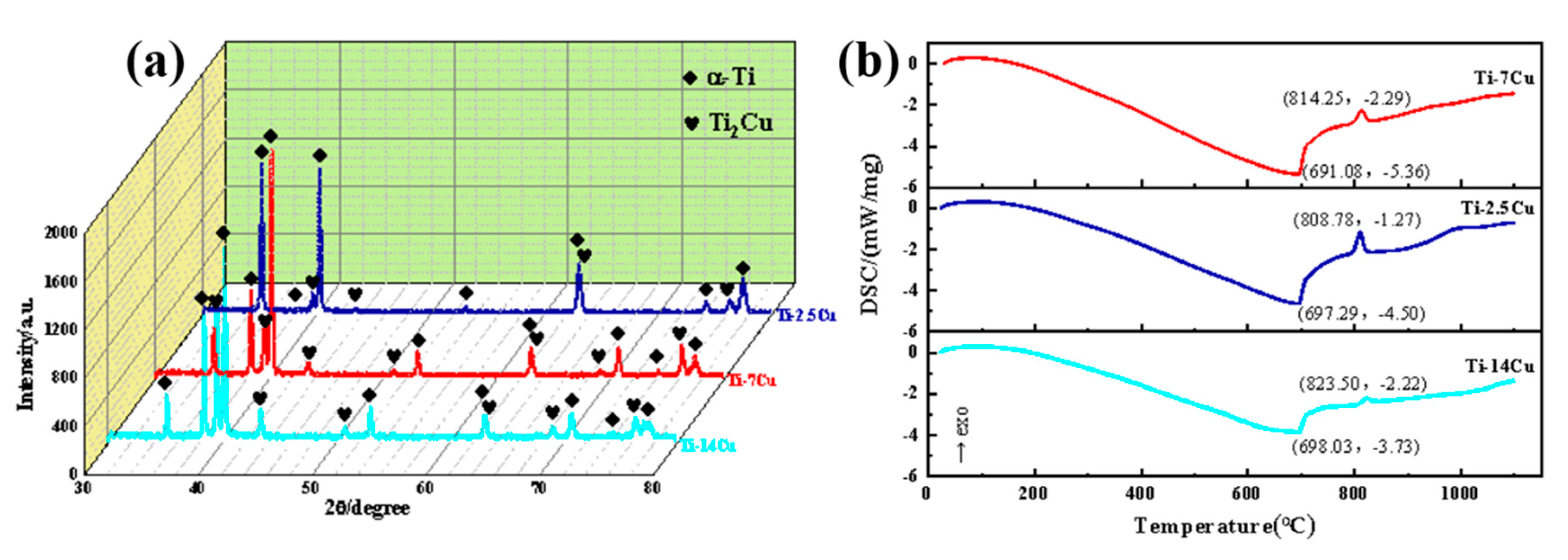


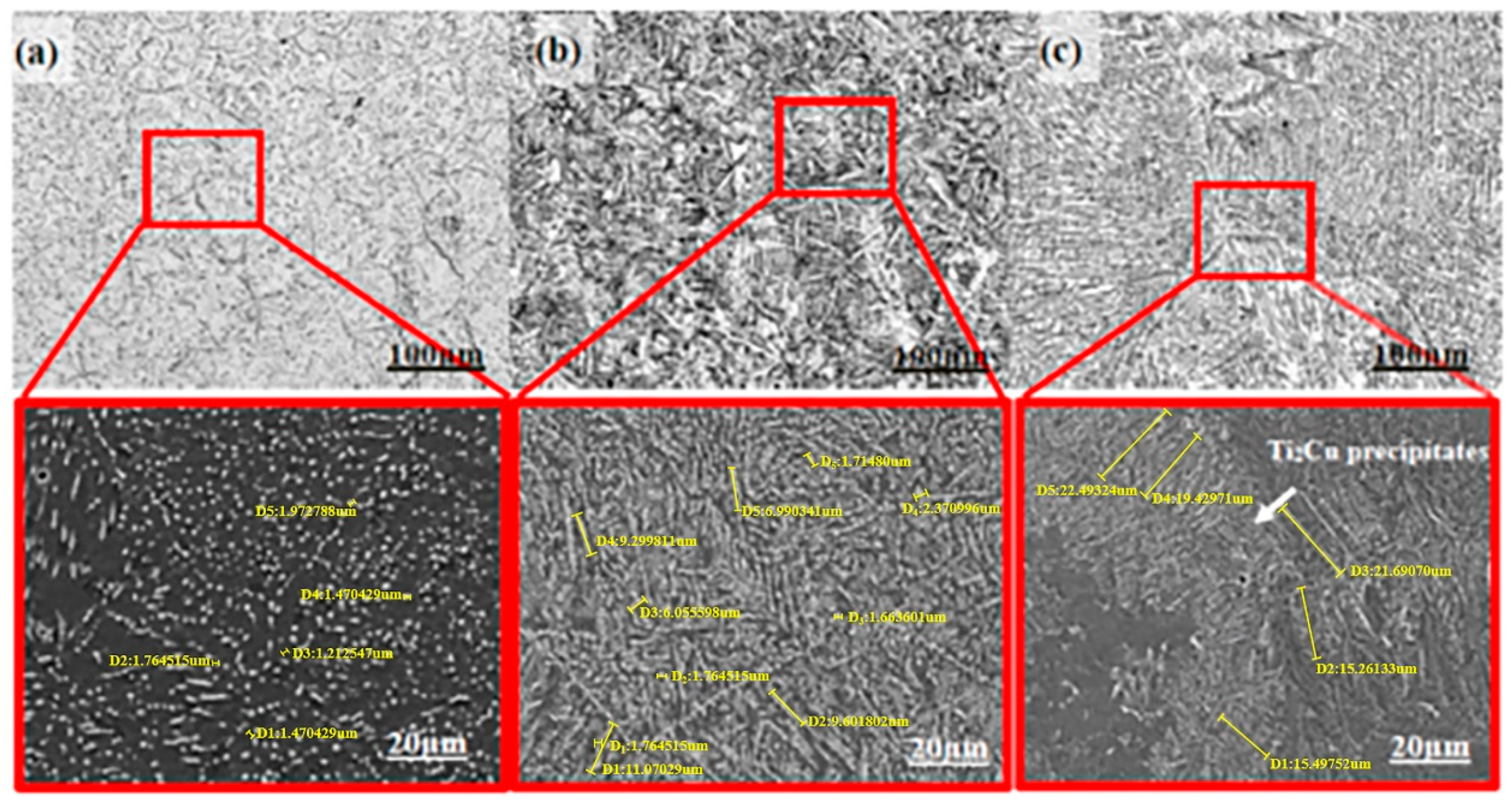

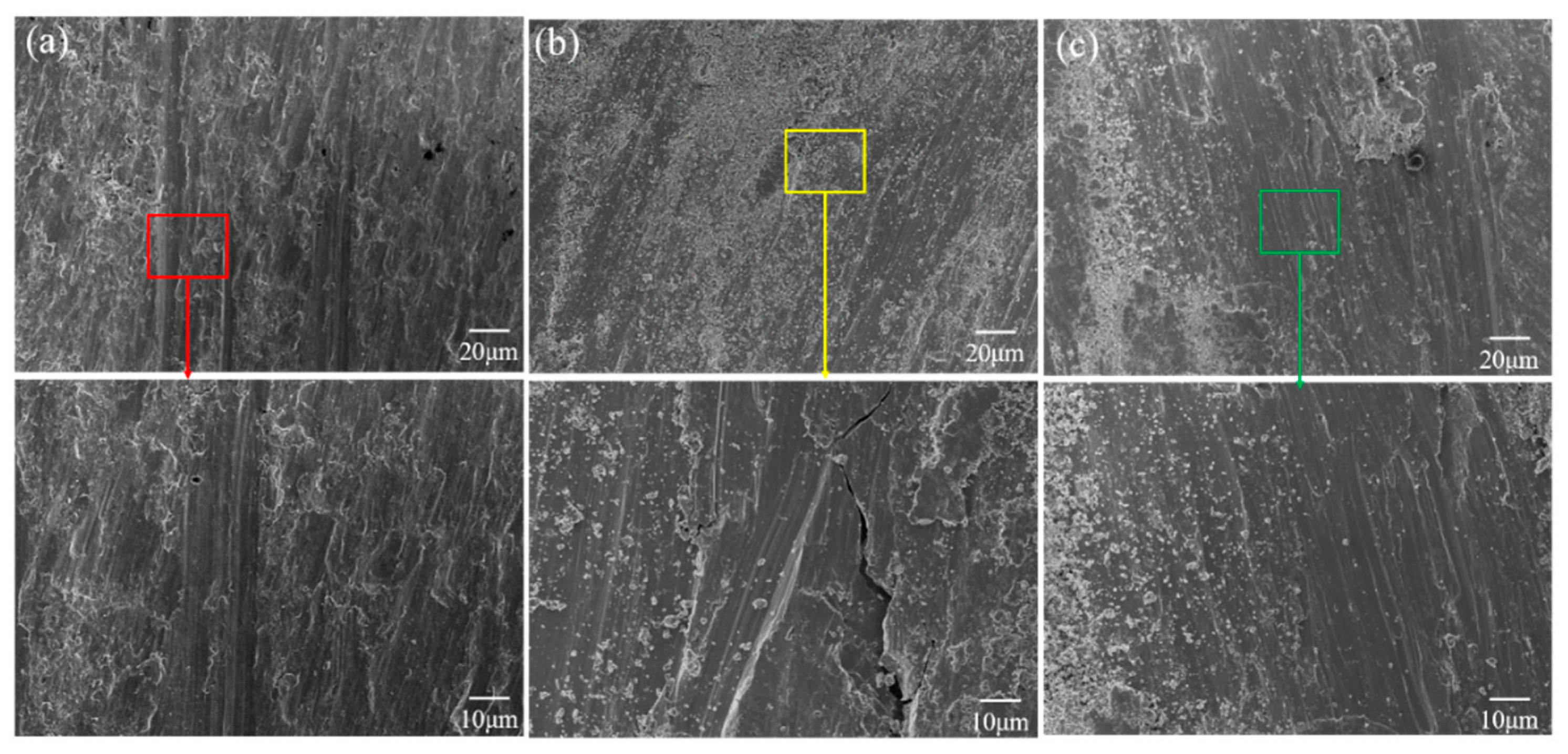
| Ti-Cu Alloy | Cu wt.% | Al wt.% | Si wt.% | O wt.% | N wt.% | C wt.% | Ti wt.% |
|---|---|---|---|---|---|---|---|
| Ti-2.5Cu | 2.5 | 0.3 | 0.7 | 0.05 | 0.009 | 0.02 | Bal |
| Ti-7Cu | 7.0 | 0.3 | 0.7 | 0.05 | 0.009 | 0.02 | Bal |
| Ti-14Cu | 14.0 | 0.3 | 0.7 | 0.05 | 0.009 | 0.02 | Bal |
| Ti-Cu Alloy | D1 | D2 | D3 | D4 | D5 | Average |
|---|---|---|---|---|---|---|
| Ti-2.5Cu | 1.103 | 1.516 | 1.163 | 1.103 | 1.104 | 1.198 |
| Ti-7Cu | 9.648 | 11.159 | 7.614 | 12.567 | 11.920 | 10.582 |
| Ti-14Cu | 39.585 | 58.882 | 56.038 | 62.846 | 67.320 | 56.934 |
| Ti-Cu Alloy | D1 | D2 | D3 | D4 | D5 | Average |
|---|---|---|---|---|---|---|
| Ti-2.5Cu (granular) | 1.470 | 1.765 | 1.213 | 1.470 | 1.973 | 1.578 |
| Ti-7Cu (granular) Ti-7Cu (short strip) | 1.765 11.070 | 1.765 9.602 | 1.664 6.056 | 2.371 9.300 | 1.715 6.990 | 1.856 8.604 |
| Ti-14Cu (acicular) | 15.498 | 15.261 | 21.690 | 19.430 | 22.493 | 18.874 |
| Concentration of Cu (wt.%) | Grain Boundaries | Intracrystalline | ||||
|---|---|---|---|---|---|---|
| 1 | 2 | 3 | 4 | Average | ||
| Ti-2.5Cu | 4.32 | 3.18 | 3.76 | 3.38 | 3.66 | 2.21 |
| Ti-7Cu | 8.58 | 7.91 | 9.44 | 9.17 | 8.78 | 7.3 |
| Ti-14Cu | 22.17 | 18.23 | 18.34 | 23.02 | 20.44 | 12.7 |
© 2020 by the authors. Licensee MDPI, Basel, Switzerland. This article is an open access article distributed under the terms and conditions of the Creative Commons Attribution (CC BY) license (http://creativecommons.org/licenses/by/4.0/).
Share and Cite
Xu, Y.; Jiang, J.; Yang, Z.; Zhao, Q.; Chen, Y.; Zhao, Y. The Effect of Copper Content on the Mechanical and Tribological Properties of Hypo-, Hyper- and Eutectoid Ti-Cu Alloys. Materials 2020, 13, 3411. https://doi.org/10.3390/ma13153411
Xu Y, Jiang J, Yang Z, Zhao Q, Chen Y, Zhao Y. The Effect of Copper Content on the Mechanical and Tribological Properties of Hypo-, Hyper- and Eutectoid Ti-Cu Alloys. Materials. 2020; 13(15):3411. https://doi.org/10.3390/ma13153411
Chicago/Turabian StyleXu, Yiku, Jianli Jiang, Zehui Yang, Qinyang Zhao, Yongnan Chen, and Yongqing Zhao. 2020. "The Effect of Copper Content on the Mechanical and Tribological Properties of Hypo-, Hyper- and Eutectoid Ti-Cu Alloys" Materials 13, no. 15: 3411. https://doi.org/10.3390/ma13153411
APA StyleXu, Y., Jiang, J., Yang, Z., Zhao, Q., Chen, Y., & Zhao, Y. (2020). The Effect of Copper Content on the Mechanical and Tribological Properties of Hypo-, Hyper- and Eutectoid Ti-Cu Alloys. Materials, 13(15), 3411. https://doi.org/10.3390/ma13153411




